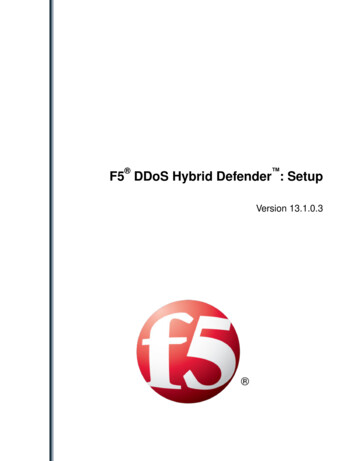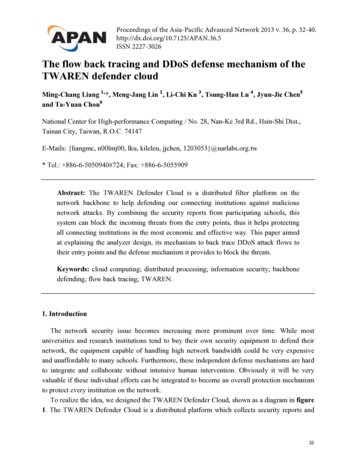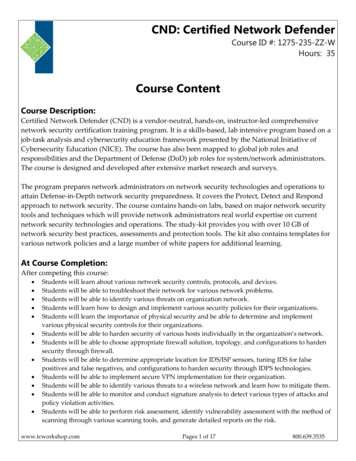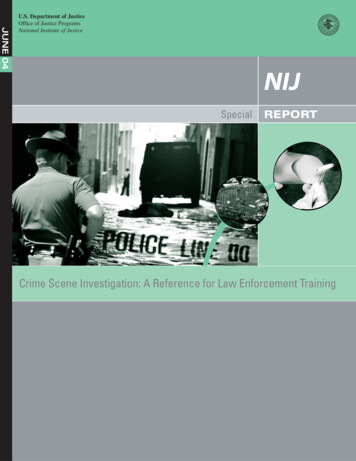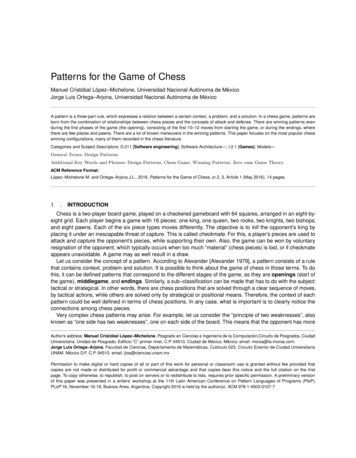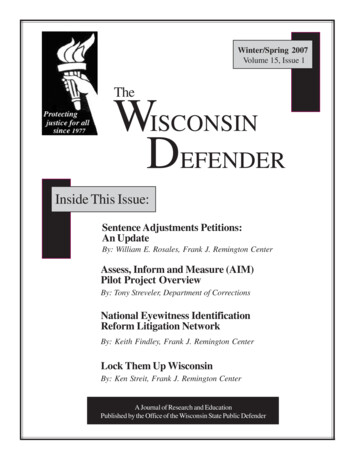
Transcription
Winter/Spring 2007Volume 15, Issue 1TheWISCONSINDEFENDERInside This Issue:Sentence Adjustments Petitions:An UpdateBy: William E. Rosales, Frank J. Remington CenterAssess, Inform and Measure (AIM)Pilot Project OverviewBy: Tony Streveler, Department of CorrectionsNational Eyewitness IdentificationReform Litigation NetworkBy: Keith Findley, Frank J. Remington CenterLock Them Up WisconsinBy: Ken Streit, Frank J. Remington CenterA Journal of Research and EducationPublished by the Office of the Wisconsin State Public Defender
Wisconsin DefenderWinter/Spring 2007The Wisconsin Defender is published bythe Office of the Wisconsin State PublicDefender and is available in electronicformat at no cost to all public defenders inWisconsin, all private bar attorneys acceptingWisconsin public defender cases, allWisconsin judges and, upon request, otherinterested readers. Hard copy subscriptionsare available to prison inmates at an annualcost of 5.00. For subscription information,contact Gina Pruski at the address below.The views and opinions expressed in theWisconsin Defender are those of theauthors and do not necessarily representthe views and opinions of the Office of theWisconsin State Public Defender.The material contained in the WisconsinDefender does not constitute legal advice.The material is intended for considerationby attorneys and other professionalsworking in the legal field. The materialshould not be relied upon when makingdecisions without first consulting with anattorney.The Wisconsin Defender welcomes allcomments and suggestions for articles.Please submit your comments and articlesuggestions to Gina Pruski at the addressbelow.Office of the Wisconsin State Public Defender315 North Henry Street2nd FloorMadison, WI 53703Tel 608.266.0087Fax 608.267.0584E-mail: pruskig@opd.wi.govWeb: http://www.wisspd.org/Page 2Wisconsin DefenderEditorGina M. PruskiEditorial Advisory BoardKenneth P. CaseyDiana FelsmannHonorable Patrick J. FiedlerKeith A. FindleyStephen P. HurleyKenneth L. LundMiguel MichelMeredith RossMichael TobinMichael YovovichState Public DefenderNicholas L. ChiarkasDeputy State Public DefenderKelli S. ThompsonBoard of DirectorsDaniel M. Berkos, ChairJames M. BrennanWilliam DrenglerRegina DunkinJohn HoganJoe G. MoralesEllen M. ThornNancy C. WetterstenMai Neng Xiong
Wisconsin DefenderWinter/Spring 2007In This IssueSentence Adjustment Petitions: An UpdateBy: William E. RosalesPage 4Assess, Inform and Measure (AIM) Pilot Project OverviewBy: Tony StrevelerPage 13National Eyewitness Identification Reform Litigation NetworkBy: Keith FindleyPage 16Review Granted in the WisconsinSupreme CourtPage 16Lock Them Up WisconsinBy: Ken StreitPage 19Criminal Jury Instruction Committee ReportBy: Charles VetznerPage 21Recent Law Review ArticlesPage 23Agency MissionTo enhance the quality of justice throughout Wisconsin by providing high quality, compassionate, and costeffective legal representation; protecting the rights of the accused; and advocating as a criminal justice partnerfor effective defender services and a fair and rational criminal justice systemPage 3
Wisconsin DefenderWinter/Spring 2007Sentence Adjustment Petitions: An UpdateBy: William RosalesIntroductionSince the passage of the Truth-in-Sentencing (TIS) regime, the legislature has created several mechanisms toallow the early release of TIS inmates. One of those mechanisms is the sentence adjustment statute, whichwas passed by Act 109 codified as Wis. Stat. sec. 973.195. The sentence adjustment statute allows thesentencing court to adjust the confinement portion of a TIS prison sentence after either 75 or 85 percent ofthe prison portion has been served.1 Whether an inmate is eligible for a 25 or a 15 percent reduction in theconfinement portion is dependent on the classification of the crime the inmate is serving time on. If an inmateis serving time on a Class C, D or E felony, he or she may petition the sentencing court for a sentenceadjustment after serving 85 percent of the prison portion.2 An inmate serving time on a Class F, G, H, or Ifelony may petition the sentencing court after serving 75 percent of the prison portion.3Since the sentence adjustment statute came into effect, there have several developments in the courts withregard how to apply and interpret the statute as well as new legislative proposals. A recent proposal tochange the sentence adjustment process appears in Governor Doyle’s 2007 Budget Proposal. It includes aprovision that would rename the Parole Commission the “Earned Release Review Commission (ERRC).”4If the legislation is passed, the ERRC will have the authority to adjust an inmate’s confinement portion if heor she completed 75 percent of the confinement and if he or she meets one of the grounds for adjustment(these grounds are identical to the sentence adjustment petition currently in place): a) conduct and efforts atand progress in rehabilitation, or participation and progress in education, treatment, or other correctionalprograms since sentencing; b) a change in law and procedure effective after the inmate was sentence thatwould have resulted in a shorter term of confinement in prison, if the change had been applicable when theinmate was sentenced; c) the inmate is subject to confinement another state or the inmate is in the UnitedStates illegally and maybe be deported; or d) sentence adjustment is otherwise in the interest of justice.5The ERRC will be limited to reviewing and granting petitions only from inmates who were sentenced to abifurcated sentence for a Class F, G, H, and I felony.6 Further, for all intents and purposes, it seems that theERRC will be the only agency allowed to make these types of sentence adjustment decisions, thereforedisallowing a trial court’s ability to grant sentence adjustment petitions under Wis. Stat. 973.195.7 Again—since the ERRC is only given authority to grant sentence adjustments to Class F-I felonies, it appears thatthe trial courts will maintain the ability to grant sentence adjustment petitions for inmates convicted for ClassC-E felonies.8In light of the evolving nature of the TIS legislation, it is imperative to examine the legal developments takingplace in applying and interpreting the sentence adjustment statue. In order to best advice clients who areeligible for sentence adjustment, the Wisconsin criminal defense bar needs to understand how to best craft apetition that provides a court sufficient knowledge with regard to your client’s completed rehabilitation andpost-prison release plans.This article summarizes the relevant sentence adjustment case law since 2005. Further, this article attemptsto examine and analyze existing sentence adjustment data to provide insight into any observable trends.Finally, the article provides advice to practitioners on how best to craft a sentence adjustment petition.BackgroundSince the enactment of the sentence adjustment statute, it is unclear what the “proper” factors a court shouldPage 4
Wisconsin DefenderWinter/Spring 2007take into account when exercising discretion to grant or deny a petition. The statute sets out several basesan inmate may petition the court in order to adjust their sentence, as follow:a) conduct, efforts at and progress in rehabilitation, or participation and progress in education,treatment, or other correctional programs since sentencing;b) a change in law and procedure effective after the inmate was sentenced that would have resultedin a shorter term of confinement in prison, if the change had been applicable when the inmate was sentence;c) the inmate is subject to confinement another state or the inmate is in the United States illegally andmaybe be deported; ord) sentence adjustment is otherwise in the interest of justice.9Meredith Ross’s 2005 article, “Sentence Modification and Early Release for TIS Inmates” provides anexcellent summary of the eligibility, grounds and procedure for sentence adjustment.10 At the time ofProfessor Ross’s article, three important cases regarding the sentence adjustment statute were pendingbefore the Wisconsin Supreme Court. State v. Trujillo11, State v. Tucker12, and State v. Stenklyft13provided some clarification as to the application and scope of the sentence adjustment statute. These casesare briefly summarized below.State v. Trujillo: Changes in Penalties Post-Sentencing Is Not a “New Factor” under SentenceModification JurisprudenceTrujillo addressed whether the reduction in the maximum penalties permitted by the TIS-II legislationconstituted a “new factor” for purposes of sentence modification.14 Trujillo specifically asked the SupremeCourt to overrule the court of appeals’ decision15 in State v. Torres which held that “a change in theclassification of a crime, which would result in a shorter sentence if the defendant were convicted under thenew classification” did not constitute a “new factor” under sentence modification.16 The Court answered noand affirmed the court of appeals’ decision in Torres.17Defendant Trujillo pled guilty to the crimes of burglary (Class C felony) and fourth degree sexual assault(Class A misdemeanor) on July 22, 2002.18 The trial court sentenced Trujillo to 8 years of initialconfinement and 5 years of extended supervision.19 Trujillo, like many other defendants, was sentencedafter the TIS-I legislation came into effect and before the TIS-II legislation was enacted. 20 Under TIS-I,the crime of burglary was a Class C felony and carried a maximum penalty of 15 years; 10 years of initialconfinement and 5 years of extended supervision.21 Under TIS-II, the crime of burglary was classified to aClass F felony with a maximum penalty of 12.5 years; 7.5 years of initial confinement and 5 years ofextended supervision.22 Trujillo was given a higher sentence under TIS-I than he would have received underthe reduced penalties under TIS-II.23In Trujillo, the Supreme Court held that the TIS-II’s “reduced maximum confinement for the same TIS-Ifelony does not constitute a new factor.”24 Since the legislature did not mandate the retroactive applicationof the reduced penalties25 and the case law had not recognized reduction in maximum sentencing as a “new“factor,” the Court rejected expanding the “new factor” jurisprudence.26 The Trujillo court held that the“adequate” remedy for inmates in similar postures like Trujillo would need to apply for a sentenceadjustment petition under Wis. Stat. sec. 974.195.27 Not only was the Court’s decision based on theirunderstanding of the TIS-II legislation, but the Court was also concerned about the potential consequencesto the court docket of finding a “new factor” under the facts presented, because over 10,700 inmates weresentenced between the time TIS-I enacted and the date TIS-II was implemented.28State v. Tucker: Sentence Adjustment applies to TIS-I InmatesPage 5
Tucker clarified two significant issues in the administration of the sentence adjustment statute: whether TISI inmates were eligible for sentence adjustment and how to calculate “applicable percentage” for crimes thatwere re-classified under TIS-II.29 Like Trujillo, Defendant Tucker pled guilty to two crimes that carriedhigher sentences under TIS-I than under TIS-II.30 Applying the Trujillo holding, the Supreme Court deniedTucker’s attempt to recognize the penalty reductions under TIS-II as a “new factor” for purposes of asentence modification.31Besides addressing the “new factor” issues, the Court decided two other matters not addressed in Trujillo.The State argued that the sentence adjustment statute did not apply to TIS-I offenders because the statute“utilizes the TIS-II felony classification system to determine the ‘applicable percentage’ of the term of initialconfinement a person must serve in order to be eligible for sentence adjustment.”32 Reasoning that the textof the sentence adjustment statute is ambiguous, the Court held that the legislature could have, but did not,limit the application of the statute to only TIS-II offenders. Because the statute itself provides a mechanismto adjust sentenced based in a change in law or procedure related to sentencing, the statute equally appliesto TIS-I offenders.33Furthermore, the Court also held that for purposes of determining the applicable percentage a TIS-Ioffender must serve in order to be eligible for sentence adjustment, one only needs to look to how the crimefor which the offender is convicted is classified under TIS-II.34State v. Stenklyft: District’s Attorney’s “No adjustment for you!”35provision in the SentenceAdjustment Statute is UnconstitutionalState v. Stenklyft raises and answers the question of the constitutionality of the district attorney’s absoluteright to veto a petition brought pursuant to the sentence adjustment statute. The sentence adjustment statutestates that “if the district attorney objects to the adjustment of the inmate’s sentence within 45 days ofreceiving notification , the court shall deny the inmate’s petition.”36 In Stenklyft, the trial court granted thesentence adjustment petition over the objection of the State, finding that Stenklyft “had done very well inprison taken advantage of all the opportunities available to [him] and [had] gone beyond what [he] had todo to try to rehabilitate [himself].”37 The State argued that 1) Stenklyft’s good behavior was not a “newfactor” and thus did not serve a basis for sentence adjustment; 2) Although Stenklyft was a model prisoner,“his behavior and efforts at rehabilitation were what is expected of prisoners”; and 3) the State had the rightto unilaterally veto the petition.38 On a motion for reconsideration, the State further argued that the sentenceadjustment statute applied only to crimes governed under TIS-II.39From casual observation, State v. Stenklyft is in odd case for any legally trained attorney to read. From theoutset, the lead opinion holds that the district attorney’s veto provision provided in the sentence adjustmentstatute does not violate separation of power principles (and is hence constitutional) and has no bearing onthe court’s inherent powers to modify a sentence.40 The lead opinion, though, does not lead the day. Withthree written opinions with some justices concurring in part with the lead opinion and dissenting in part, thecombination provides for a majority to declare that as follow:Wis. Stat. § 973.195 should be interpreted, to save it constitutionality, sothat a circuit court has discretion to consider (but is not bound by) a districtattorney’s objection to a petition for sentence adjustment, and (2) to declareunconstitutional the lead opinion’s interpretation of Wis. Stat. § 973.195 togrant a district attorney a veto power over a petition for sentenceadjustment.41
The majority reasons that the judicial power is compromised “when the district attorney is given theunilateral power” to end a trial court’s consideration whether to grant a petition provided under Wis. Stat.973.195.42 To allow for such unilateral power on the part of district attorney is to allow the legislature to“directly affect the judicial branch’s role .to impose sentence penalty and exercise discretion in adjusting thelength of a sentence that a court has imposed.”43 To limit the trial court in such manner is to deny a petitionnot on its merits, but merely on the district attorney’s power on any particular petition to declare “NoAdjustment for you!”44 The court finds notable the fact that the sentence adjustment petition “must be filedwith the sentencing court, not just any court,” therefore providing proof that the adjustment procedure ispart of the sentencing court’s continuing power.45The Stenklyft majority concludes that the text of the statute providing for the district attorney veto provision“evinces a clear violation of the separation of power doctrine”46 and provides that the term “shall” containedin Wis. Stat. sec. 973.195(1r)(c) is to be interpreted as “directory, thereby giving a circuit court discretionto accept or reject an objection from the district attorney.”47 Although Stenklyft decided that the districtattorney veto provision is unconstitutional, it still left the question open as to whether the victim vetoprovision encompassed in Wis. Stat. 973.195(1r)(d) is constitutional. From CCAP records, it appears thatsome sentence adjustment petitions have been denied due to objections from victims.Sentence Adjustment Petitions by the NumbersFigure 1 below demonstrates the number of sentence adjustment petitions that have been granted48 anddenied49 since 2003. Please note that Milwaukee County is excluded because according to Sarah Gunn ofthe Milwaukee Clerk of Courts, Milwaukee was unaware for a period of time the specific CCAP codes tobe used for Petitions to Sentence Adjustment.50 In light of the fact that clerks statewide might haveexperienced similar issues, the figure below is not be to be a full and adequate accounting of the sentenceadjustment petitions granted and denied, but rather is meant to highlight general trends.Overall, the percentage of petitions granted statewide has increased between 2003 and 2006.51 In 2006,the number of petitions granted was roughly 22%, a significant increase from the 4 % granted in 2003. In2006, Dane County accounted for 21 % of the 197 petitions granted and 17 % of the 704 petitions denied.Waukesha County accounted for 11% of the 197 petitions granted and 12% of the 704 petitions denied.Although the trend reflects that more sentence adjustment petitions are being granted, overall, thepercentage of petitions granted in relation to petitions denied is heavily skewed toward denial. Overall, 197of petitions filed were granted in 2006, while 704 were denied.Figure 1: Number of Sentence Adjustment Petitions Granted and Denied ExcludingMilwaukee 05Caendar YearGRANTEDDENIED2006
Wisconsin DefenderWinter/Spring 2007Figure 2 and 3 below attempt to observe the types of underlying offenses that constitute petitions grantedunder the sentence adjustment statute. Out of the 197 petitions granted statewide (excluding Milwaukee),Dane and Waukesha County accounted for a total of 66, or 34 percent of the total.52Figure 2 below represents the number of sentence adjustment petitions granted in Dane County for the2006 calendar year. Of the 197 total petitions granted statewide, Dane County granted 43 petitions. Ofthe 43 petitions granted, 33 of them were petitions where the underlying offense classification was either aClass F or a Class H felony. Within the 14 granted petitions with underlying F felonies, burglary constitutedthe underlying offense for 9 of the granted petitions. Within the 19 granted petitions with underlying Hfelonies, forgery and bail jumping constituted the underlying offense for 16 of the granted petitions (8 foreach).The sentence adjustment statute does not provide that individuals sentenced as misdemeanor habitualcriminals under Wis. Stat. sec. 939.62(1)(a) are eligible for sentence adjustment. Interestingly enough, areview of the 43 petitions granted in Dane County reveals that judges in at least 4 cases granted sentenceadjustment for misdemeanor habitual criminal cases. To date, there are no reported published orunpublished cases addressing the question as to whether they can submit a petition for sentence adjustment.Fairness surely dictates that these inmates should be eligible to submit a petition under Wis. Stat. 973.195,even though misdemeanor repeaters are not included in section (1g) that addresses the classification ofcrimes for purposes of assessing the “applicable percentage.” Further, misdemeanor repeaters are surelyserving a sentence under Wis. Stat. 973.01 for a crime other than Class B felony and hence arguably“eligible” pursuant section (1r) of Wis. Stat. 973.195. The question becomes what applicable percentage—75 or 85 percent—of the term of confinement in prison do they serve before they can apply for a sentenceadjustment. In light of the less aggravated nature of their underlying offense, common sense and fairnessargument suggest that they should apply for a sentence adjustment when they have served 75 percent oftheir confinement time.Figure 2: Number of Sentence Adjustment Petitions Granted by OffenseClassification in Dane County in Calendar Year 20061920141510541410CFHIGMisd. A/BTIS-II Offense Classification2006Figure 3 below represents the number of sentence adjustment petitions granted in Waukesha County for thePage 8
Wisconsin DefenderWinter/Spring 20072006 calendar year. Of the 197 total petitions granted statewide, Waukesha County granted 23 petitions.Of the 23 petitions granted, 16 were petitions where the underlying offense classification was either a ClassF or a Class H felony. Unlike Dane County, there seem to be a variety of underlying offenses that constitutethe petitions granted. Overall, though, non-violent underlying offenses constitute the majority of the petitionsgranted. Of the 23 petitions granted, 4 of them had forgery as an underlying offense, 7 of them hadburglary/theft as an underlying offense and 5 of the them had operating while under the influence (5th) as anunderlying offense.Figure 3: Number of Sentence Adjustment Petitions Granted by OffenseClassification in Waukesha County in Calendar Year 200610888HI664210CFTIS-II Offense Classification2006How can I effectively assist my client with a sentence adjustment petition?Defendants are not entitled to State Public Defender representation on sentence adjustment petitions.However, some defense attorneys are receiving requests to represent inmates in these petitions. Thissection provides some insights that may help you better represent inmate clients in these cases.Unfortunately, Wis. Stat. sec. 973.195 and the legislative history of the statute provide very little in the wayof standards or guidance as to how a judge should decide whether to grant a sentence adjustment petition.In Stenklyft, the circuit court judge in granting the petition shared the concern that “a lot of judges aroundthe state view this law [Wis. Stat. 973.195] with some skepticism because there are not standards in thestatute that tell us what we’re supposed to be looking at.”53It is the experience of the Remington Center that the more information you provide to the sentencing courtwith regard to your client’s programming and rehabilitation successes, as well as employment and livingoptions post-release, the better your client will fare in front of the court. Although the Wisconsin CourtSystem and the Department of Corrections (DOC) require the use of standard forms54 when submitting apetition for sentence adjustment, it is incumbent upon counsel to submit a supplemental petition attached tothe required forms to provide the sentencing court a thorough reflection on your client’s reasons why thecourt should grant the petition.Timing: Defendants eligible for sentence adjustment petitions are not eligible to apply until the have servedthe “applicable percentage” time in confinement depending on the underlying TIS-II offense classification.Since the statute in effect provides the circuit court an undetermined time to consider the sentenceadjustment petition55 and further provides 45 days for the district attorney to respond if they receive noticePage 9
Wisconsin DefenderWinter/Spring 2007from the circuit court that they are considering thepetition,56 it is vital that petitions are filedimmediately after an inmate become eligible.57Therefore, it is important that you gather thesupporting documents and information you will needfor a supplemental petition. In some cases, it islikely that the time of confinement might be servedby the time the various court actors respond to thesentence adjustment petition. In fact, in 2006 ajudge in Dane County had to vacate an ordergranting a sentence adjustment petition because bythe time it was granted, the inmate had alreadyserved the entire confinement period.it easier for the inmate once he or she is releasedwould also be helpful.A common logistical problem with inmates is thatthey may not get accepted into the treatment and orprogramming that they need by the time they areeligible for a sentence adjustment. If that is the case,counsel should research community organizationsand or agencies that will be available for your clientupon release, so that he or she could take treatmentand or programming on an outpatient basis.Request a Hearing: Although Wis. Stat. sec.973.195 does not give an inmate a statutory right forContent of Supplemental Petition: Unlike thea hearing on the petition, you should request one andEarned Release Program (another TIS early release request that your client appear in person. As part ofmechanism) where the DOC determine whether anthe required forms that the prison records supervisorinmate has successfully completed the program andhas to fill out in order to verify that the inmate servedinforms the sentencing court of that fact,58 thethe applicable percentage of confinement time, thesentence adjustment statute does not provide for any records supervisor also submits copies of any“offender conduct reports” that the inmate hasstatutory or administrative framework that providesa sentencing court with the necessary information to received while incarcerated. Presumably, beforesubmitting a supplemental petition, you havedecide whether to grant a petition.59 The mostreviewed your client’s conduct reports. Onecommon ground that an inmate will petition for astrategy would be to recognize any bad conduct insentence adjustment is because he or she has takenthe supplemental petition and try to mitigate it.advantage of the treatment and programming60Another strategy is to not recognize it in your writtenopportunities while incarcerated. However, therequired forms to request a sentence petition do not supplemental petition but respond to it if it comes upduring the hearing on the petition. Your choice ofsufficiently provide the court with this type ofstrategy will depend on what is in the conduct reportinformation. Thus, a supplemental petition shouldand whether you need to clarify to the court whatdemonstrate the treatment and rehabilitationexactly the conduct report means. In general, anopportunities that your client has completed. Thesupplemental petition should also include as exhibits “offender conduct report” includes a “decisiondate”, a “violation”, “time extended” andany copies of certificates and or awards that your“disposition.” Under the “violation” column, theclient has received while incarcerated.report will probably only include a rule and a rulenumber pursuant to the DOC’s Discipline Code.61A common concern that the Remington Center hasheard from judges is that sentence adjustmentThe report is not meant to provide thoughtfulpetitions do not include information as to theinformation as to what actually occurred that lead toinmate’s post-release plans. Since the sentencinga conduct report, but rather is a summary report thatjudge is deciding whether to release an inmate fromDOC keeps to keep track of an offender’s conductconfinement, you and the client should present arecord. In that respect, the report correctly uses“parole” plan for the judge to consider. Suchrule numbers and DOC short-hand to serve theinformation should include any employment andDOC’s purposes. The problem with these reports ishousing options that are available once the inmate is that they do not give the sentencing judge anyreleased from confinement. Information and orthoughtful information about what exactly the inmateaffidavits attesting to a support system that will make did to receive a conduct report. A hearing might bePage 10
Wisconsin DefenderWinter/Spring 2007useful to explain or mitigate such conduct reports if itbecomes an issue before the sentencing court.Further, it is not unheard of for a district attorney torequest a records supervisor to appear in person orvia the telephone at a sentencing adjustment hearingin order to explain to the judge what exactly iscontained in the offender conduct report.ConclusionThe application and interpretation of the sentenceadjustment statute is still evolving. Although the datasuggest that a majority of sentence adjustmentpetitions will be denied, the trend since 2003 is apositive one. Crafting and submitting to thesentencing court a thoughtful supplemental sentenceadjustment petition might go a long way in increasingthe chances that a judge might release an inmateclient from confinement.Endnotes1. Wis. Stat. § 973.195 (2005-06).2. Id.3. Id.4. See Legislative Reference Bureau, “2007-09Wisconsin State Budget; Summary of Governor’sBudget Recommendations” at ernor/tableofcontents.htm (last visited April 22, 2007);See also Calllender, David, “ Doyle’s BudgetSurprises: ‘Truth in Sentencing’ take hit.” CapitalTimes, March 7, 2007, at A1, also at http://www.madison.com/archives/read.php?ref /tct/2007/03/07/0703070432.php (last visited April 22,2007).5. Id.6. Id.7. Id.8. Id.9. Wis. Stat. § 973.195.10. Ross, Meredith, Sentencing Modification andEarly Release for TIS Inmates, THEWISCONSIN DEFENDER, Winter/Spring 2005.11. State v. Trujillo, 2005 WI 45, 279 Wis. 2d712, 649 N.W.2d 933.12. State v. Tucker, 2005 WI 46, 279 Wis. 2d697, 694 N.W.2d 926.13. State v. Stenklyft, 2005 WI 71, 281 Wis. 2d484, 697 N.W.2d 769.14. Trujillo, 2005 WI 45, ¶ 11.15. Trujillo, 2005 WI 45, ¶ 15.16. State v. Torres, 2003 WI App 199, ¶ 7, 267Wis. 2d 213; 670 N.W.2d 400.17. Trujillo, 2005 WI 45, ¶ 19.18. Trujillo, 2005 WI 45, ¶ 7.19. Id.20. Trujillo, 2005 WI 45, ¶ 6-7.21. Trujillo, 2005 WI 45, ¶ 8.22. Id.23. Trujillo, 2005 WI 45, ¶ 7-8.24. Trujillo, 2005 WI 45, ¶ 2.25. Trujillo, 2005 WI 45, ¶ 21-22.26. Trujillo, 2005 WI 45, ¶ 21.27. Trujillo, 2005 WI 45, ¶ 25.28. Trujillo, 2005 WI 45, ¶ 28.29. Tucker, 2005 WI 46, ¶ 2.30. Tucker, 2005 WI 46, ¶ 3-4.31. Tucker, 2005 WI 46, ¶ 8-9.32. Tucker, 2005 WI 46,
Madison, WI 53703 Tel 608.266.0087 Fax 608.267.0584 E-mail: pruskig@opd.wi.gov . To enhance the quality of justice throughout Wisconsin by providing high quality, compassionate, and cost-effective legal representation; protecting the rights of the accused; and advocating as a criminal justice partner for effective defender services and a fair .



